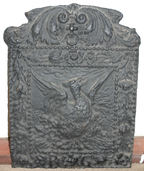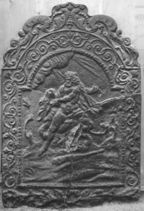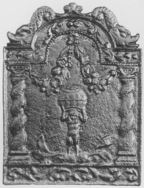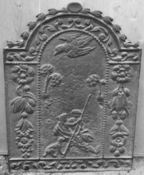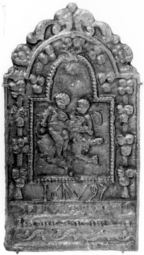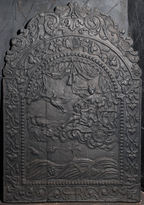-
154
Description: Rectangular central panel with bead edging; a phoenix, with wings displayed, rising from the flames; rectangular border with bead edging, flowers and leaves festooned from a central flower; initials split either side of a flower at the base; on top, symmetrical swirled leaves.
Notes: Although similar to 'Dutch' types made in north Germany, this is probably an English design. A fireback bearing a phoenix was one of three designs ordered by Trubshaw's, ironmongers of London and Birmingham, from George Sitwell's furnace at Foxbrooke, Derbyshire, in the 1660s. Formerly part of the Ade Collection (from Grove Hill, Hellingly, Sussex).
Copies of this fireback are known.
Inscription: R (or B) G
- Decoration tags:
- 'Dutch' (shape)
- bead (edging)
- whole carved pattern
- individual letters
- mythological
- text
- animals
Manufactured: in the mid- to late-17th century in England.
Current location: Hastings Museum and Art Gallery, John's Place, Bohemia Road, Hastings, East Sussex, England.
Museum number: HASMG: 1952.51.16 (part of the Hastings Museum museum group)
Citation: Lloyd, N., 1925, 'Domestic Ironwork I', Architectural Review, 58, pp. 58-67.
Citation: Riden, P., 1985, George Sitwell's Letterbook, 1662-66 (Derbyshire Record Society vol. 10).
- Attached to series:
- British 'Dutch' style firebacks
- Phoenix firebacks
-
155
Description: Arched rectangular shaped central panel with paternost bead edging; Hercules/Herakles slaying the Nemean lion on a ground with small trees, his club lying at his feet; above, clouds and sun rays; arched rectangular shaped border with fillet edging, symmetrical arrangement of swirled tendrils, floral wreath at base; on top, symmetrical arrangement of foliage.
Notes: The image is taken from an engraving by Gerard de Jode, from his series 'The Labours of Hercules', after Marcus Geeraerts, 1519 - 1591. One of many English firebacks which copied 'Dutch' styles. Formerly part of the Ade Collection (from Grove Hill, Hellingly, Sussex).
Copies of this fireback are known.
- Decoration tags:
- 'Dutch' (shape)
- fillet (edging)
- whole carved pattern
- pictorial
- mythological
- humans
Manufactured: in the early-18th century in England.
Current location: Hastings Museum and Art Gallery, John's Place, Bohemia Road, Hastings, East Sussex, England.
Museum number: HASMG: 1952.51.27 (part of the Hastings Museum museum group)
- Attached to series:
- British 'Dutch' style firebacks
-
160
Description: Arched rectangular shaped panel with fillet edging; two Salomonic columns supporting a beaded arch; standing figure of Atlas supporting a globe, on ground with plants, and two swags of fruit and leaves suspended from the centre of the arch to the capitals of the columns; above the beaded arch, symmetrical swirls of fruit and foliage; on top, a scallop shell between two sea serpents.
Notes: Probably an English design copying the north German 'Dutch' style.
Copies of this fireback are known.
- Decoration tags:
- 'Dutch' (shape)
- fillet (edging)
- whole carved pattern
- mythological
- architectural
- humans
- plants
- objects
Manufactured: in the late-17th to early-18th century in England.
Current location: Hastings Museum and Art Gallery, John's Place, Bohemia Road, Hastings, East Sussex, England.
Museum number: HASMG: 1917.196.6 (part of the Hastings Museum museum group)
Citation: Butterfield, W. R., 1916, 'Old Wealden Firebacks', The Connoisseur, 46, pp. 197-209.
Citation: Lloyd, N., 1925, 'Domestic Ironwork I', Architectural Review, 58, pp. 58-67.
Citation: Baines, J. M., 1958, Wealden Firebacks (Hastings Museum).
- Attached to series:
- British 'Dutch' style firebacks
-
163
Description: Arched rectangular shape with fillet edging; tall, arched central panel with bead edging (top and sides); flying bird in arch, with two small trees below, and two figures, one with a staff in his right hand, and a dog, at the bottom; two side panels with similar cascades of flowers; narrow base panel with fillet edging and symmetrical floral arrangement; on top, a scallop shell between two symmetrical lines of trailing flowers.
Notes: The figures may be Venus and Adonis, the bird aboive being a dove; probably an English design based on the 'Dutch' style. Formerly part of the Ade Collection (from Grove Hill, Hellingly, Sussex).
Manufactured: in the late-17th to early-18th century in England.
Current location: Hastings Museum and Art Gallery, John's Place, Bohemia Road, Hastings, East Sussex, England.
Museum number: HASMG: 1952.51.31 (part of the Hastings Museum museum group)
- Attached to series:
- British 'Dutch' style firebacks
-
187
Description: 'Dutch' style; arched rectangular shaped central panel, bead edging, two children sitting astride a beast (possibly a winged ram); arched rectangular shaped border, fillet edging, swags of fruit bunches suspended from ribbon; on top, symmetrical floral swirls and flowers.
Notes: The image is probably intended to be Phryxus and Helle riding the winged ram with the golden fleece, but in recasting it has been misinterpreted as the young Samson slaying the lion at Timnath; Judges 14: 5-6. Formerly part of the Ade Collection (from Grove Hill, Hellingly, Sussex).
Copies of this fireback are known.
Inscription: 16 NDW 97 / DER IUNGE SAMSON [the young Samson]
- Decoration tags:
- 'Dutch' (shape)
- fillet (edging)
- whole carved pattern
- mythological
- monogram
- text
- humans
Manufactured: in 1697 possibly in the Siegerland area of Germany.
Current location: Hastings Museum and Art Gallery, John's Place, Bohemia Road, Hastings, East Sussex, England.
Museum number: HASMG 1952.51.28 (part of the Hastings Museum museum group)
- Attached to series:
- 'Dutch' NDW series
-
327
Description: Arched rectangular shaped central panel with open-bud edging; pictorial: Venus in her chariot drawn by doves, with her child, Cupid; a heron flies away to the left; above are swagged curtains and a pair of tassels, below is a landscape; arched rectangular shaped border with fillet edging, a scallop shell top centre with symmetrical arrangement of vine and acanthus leaves and tendrils; the monogram, SHR, bottom centre; above is a symmetrical design of scrolled floral tendrils.
Notes: The design is derived from a personification of the planet Venus in 'Planetarum effectus et eorum in signis zodiaci', by Marten de Vos (1585). Two editions of engravings of de Vos's drawings are known, by Jan Sadeler, dated 1585, and by Gregor Fentzel in about 1650. The flying heron has been copied from a print by Wenceslaus Hollar c.1658. The theft, in 1699, from a Thames-side warehouse of several firebacks, included '6 of Venus in a Chariot with Doves', which is likely to refer to this type (Post Boy 11-14 Nov. 1699).
Copies of this fireback are known.
Inscription: SHR
- Decoration tags:
- 'Dutch' (shape)
- fillet (edging)
- whole carved pattern
- planklines
- pictorial
- mythological
- allegorical
- text
- animals
- humans
Manufactured: in the late-17th century in England.
Current location: Horsham Museum, Causeway, Horsham, West Sussex, England.
(part of the Horsham Museum museum group)
- Attached to series:
- SHR series
- British 'Dutch' style firebacks
- De Vos Planets series
-
328
Description: Arched rectangular central panel with bead edging; pictorial scene of a figure in Roman dress, holding a large sword, and holding the head of a bearded man in his left hand; below to the left, a naked, decapitated body; above the winged face of a putto between mirrored, scrolled foliage; arched rectangular border with fillet edging; flowers in chain under the arch and down the sides; at the bottom, swirled foliage; on top, a crown between fruit triads.
Notes: Perseus holding the severed head of the Medusa; possibly loosely adapted from a drawing by Crispijn de Passe the elder (1564-1637). Similarities in the design and execution of the pattern suggest a common source with contemporary English firebacks.
- Decoration tags:
- 'Dutch' (shape)
- fillet (edging)
- whole carved pattern
- pictorial
- mythological
- humans
Manufactured: in the early-18th century in England.
Current location: Horsham Museum, Causeway, Horsham, West Sussex, England.
(part of the Horsham Museum museum group)
- Attached to series:
- British 'Dutch' style firebacks
-
325
Description: Arched rectangular shaped central panel with bead-and-pellet edging on a broad fillet; Jupiter in his chariot drawn by eagles; above are clouds, below is a landscape; arched rectangular shaped border with fillet edging, with a symmetrical scrolled wire design; the monogram, SHR, bottom centre; above is a symmetrical design of scrolled floral tendrils.
Notes: The design is probably adapted from a personification of the planet, Jupiter, in 'Planetarum effectus et eorum in signis zodiaci', by Marten de Vos (1585). Two editions of engravings of de Vos's drawings are known, by Jan Sadeler, dated 1585, and by Gregor Fentzel in about 1650.
Inscription: SHR
- Decoration tags:
- 'Dutch' (shape)
- fillet (edging)
- whole carved pattern
- pictorial
- mythological
- allegorical
- text
- humans
Manufactured: in the late-17th to early-18th century in England.
Current location: Horsham Museum, Causeway, Horsham, West Sussex, England.
(part of the Horsham Museum museum group)
- Attached to series:
- SHR series
- British 'Dutch' style firebacks
- De Vos Planets series
-
341
Description: Arched rectangular shaped central panel with ’nutshell,’ paternost edging on a broad fillet; figure of Neptune/Poseidon holding a trident in his right hand, standing on a pedestal in the centre of a circular fountain, with two hippocampi, water issuing from their mouths; in front, a mermaid swims in waves, her arms raised; behind, blasts of wind issue from clouds; arched rectangular border with fillet edging; symmetrical design of seashells suspended from chains of pearls; bottom centre, the monogram between swirled plant tendrils; on top, symmetrical floral swirls.
Notes: Although very similar in size and design to a fireback in the 1724 series, this is not based on a design by Daniel Marot; instead it may have been inspired by the design for a fountain by Jean Lepautre (1618-82) published in a set of 12 etchings by Jean Le Blond in 1650. Almost certainly the 'iron chimney back' purchased by Henry Campion, of Danny, from John Legas for two guineas in 1731; another example, presumably from the same source, is at The Vine, near Basingstoke, Hampshire.
Copies of this fireback are known.
Inscription: SHR
- Decoration tags:
- 'Dutch' (shape)
- fillet (edging)
- whole carved pattern
- pictorial
- architectural
- text
- animals
- humans
- objects
Manufactured: in the early-18th century possibly at Gloucester Furnace, Lamberhurst in the Weald area of England.
Current location: Danny House, Hurstpierpoint, West Sussex, England.
Citation: Brent, C. & J., 2013, Danny House (Chichester, Phillimore), pp. 58-9.
- Attached to series:
- SHR series
- British 'Dutch' style firebacks
-
981
Description: Arched rectangular shape; fillet edging; broad, fillet-edged central panel with pictorial landscape and battle scene; on top, above a cone of laurel leaves, a crown supported by two putti, each holding a plant stem; on each side, a flower and fruit festoon suspended on a ribbon from a ring; at the bottom , inscription on a scroll.
Notes: The pictorial scene is alleged to be the Siege of Namur of 1695 in which British and Dutch forces, under the leadership of William III, defeated the French forces of Louis XIV, however details of the scene more closely resemble those seen in images of the Siege of Vienna in 1683, an iconic victory of the Christian powers over the Ottoman Turks.
Copies of this fireback are known.
Inscription: NON[...]ROSEDARMIS / N ANNO 1695 L
- Decoration tags:
- 'Dutch' (shape)
- fillet (edging)
- whole carved pattern
- individual letters
- pictorial
- text
- animals
- humans
- plants
- objects
Manufactured: in 1695 possibly in the Siegerland area of Germany.
Current location: Swakeley's House, Ickenham, Middlesex, England.
Citation: Godfrey, W. H., 1933, Survey of London Monograph 13, Swakeleys, Ickenham (London, HMSO).
- Attached to series:
- 'Dutch' 1695 Crown series
